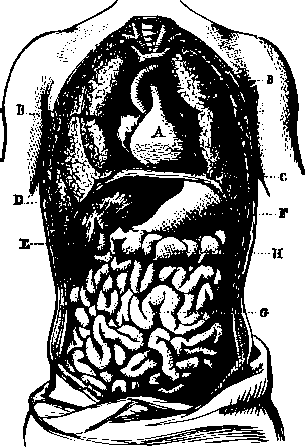The Stomach
Description
This section is from the book "Wonders Of The Human Body", by Auguste Le Pileur. Also available from Amazon: Wonders of the Human Body.
The Stomach
The form of the stomach has been compared to that of a bagpipe. It is a large pouch, an expansion of the digestive tube, placed transversely across the upper portion of the abdomen. Its left extremity or great cul-de-sac, lying in the hypochondriac region, is rounded and larger than the right, which corresponds to the epigastrium. Above, it forms a concave curve—the lesser curvature; below, a convex curve—the greater curvature. The opening by which it communicates with the oesophagus is to the right of the great cul-de-sac, and is called the cardiac orifice; and that which opens into the intestine, the pylorus, or pyloric orifice.
The walls of the stomach are formed of four membranes, which, proceeding from without inwards, are a serous—the peritoneum—a muscular, a fibrous, and a mucous membrane. The muscular membrane is composed of three layers of fibres, some longitudinal, others circular. These fibres are slender and open for the most part, but near the pylorus they are closer and stronger, and around this orifice they form a muscular ring, which has been named the pyloric valve.
The intestinal canal is a continuation of the stomach; its walls, like those of that organ, are composed of four membranes—a serous, muscular, fibrous, and mucous membrane. It is divided into the large and small intestines. The smaller intestine is composed of the duodenum, jejunum, and ileum. The duodenum is so named because it measures nearly twelve finger-breadths in length; it extends from the stomach to the jejunum, from which no line of demarcation separates it, nor is the jejunum separated from the ileum. These names indicate a purely arbitrary distinction, drawn by the ancient anatomists between these three parts of the intestinal canal. The large intestine differs from the small one externally in size, and because it presents a series of more marked enlargements. The cścum is its upper portion, of a larger calibre than the ileum, and separated from it by the ileo-caecal valve, a fold of the internal membranes designed to prevent the reflux of fluids. It opens into the ileum, not at its extremity, but by a lateral orifice; below this orifice, it forms a sort of ampulla, terminated by the appendix vermiformis. The cścum is followed by the colon, from which it is separated only by an artificial division. It is the largest and longest portion of the large intestine; it forms a curve called the arch of the colon, and is divided into the ascending-transverse, and descending colon, to which succeeds the rectum, the extremity of the intestinal canal.

Fig. 23. Transverse section of the thoracic and abdominal cavities.
A. Heart.
b. Lungs separated to show the heart.
C. Diaphragm.
D. Liver.
E. Gall-bladder.
F. Stomach.
g. Small intestine. H. Transverse colon.
The total length of the intestine is about nine yards. It occupies a large portion of the abdomen, in which it is folded in numerous convolutions.
Continue to:
